As well as producing marvellous still life bouquets, symbolic landscapes and grand portraits, the Dutch Golden Age saw the introduction of the genre painting. With an emphasis on realism and morality, these unique artworks can offer us a visual insight into the lives of patrons and peasants of the 17th century and beyond.
 Above: a selection of genre paintings by Gerard ter Borch the Younger (1650), Gabriël Metsu (1660) and Jan Steen (1663)
Above: a selection of genre paintings by Gerard ter Borch the Younger (1650), Gabriël Metsu (1660) and Jan Steen (1663)
From the wealthy interiors of Johannes Vermeer to the social revelry of Jan Steen, genre paintings can be found in major galleries and collections around the world including The National Gallery, The Royal Collection, The Metropolitan Museum Of Art, and The Rijksmuseum. Also known as the ‘petit genre’, their worldly themes set them apart from the ‘grand genre’ of fantastical history paintings.
 Above: a detail from Merry Company on a Terrace by Jan Steen, 1670
Above: a detail from Merry Company on a Terrace by Jan Steen, 1670
Many of our clients are lucky enough to have an original or copy of one of these fascinating artworks, allowing our conservators to frequently care for them in our studio. This article will look into the themes of genre paintings, as well as their conservation and restoration.
 Above: three genre paintings by Vermeer including A Maid Asleep (1656-7), Young Woman with a Water Pitcher (1662) and Young Woman with a Lute (1662-3)
Above: three genre paintings by Vermeer including A Maid Asleep (1656-7), Young Woman with a Water Pitcher (1662) and Young Woman with a Lute (1662-3)
What is a genre painting?
Genre paintings are a composition of everyday life, usually depicting a domestic or social scene. Unlike other forms of art, a genre painting has no literal portraits or mythological characters. In genre paintings, most figures are only recognised by their occupation or social status.
 Above: a detail from The Feast of St Nicholas by Jan Havicksz Steen, 1665-68
Above: a detail from The Feast of St Nicholas by Jan Havicksz Steen, 1665-68
These anonymous roles allow for a generic situation to become the focal point. Typically, genre paintings depict street scenes, marketplaces, domestic interiors, and festivities. Some of the most popular figures are children and maids, as well as dogs and cats.
 Above: a selection of genre paintings by Gabriël Metsu including The Sick Child (1664-66), The Cat’s Breakfast (1661-64) and The Hunter’s Present (1658-61)
Above: a selection of genre paintings by Gabriël Metsu including The Sick Child (1664-66), The Cat’s Breakfast (1661-64) and The Hunter’s Present (1658-61)
Whilst realistic in their approach, genre paintings often hide moral messages within their composition. These allegories would have been more obvious to a 17th century audience, as many include Netherlandish play on words or proverb (of which there are many). General themes include morality, social decline, domesticity or religious allegory.
 Above: detail from A Kitchen by Hendrick Sorgh, 1643 – this scene has erotic symbolism that would have been obvious to a 17th century viewer
Above: detail from A Kitchen by Hendrick Sorgh, 1643 – this scene has erotic symbolism that would have been obvious to a 17th century viewer
Genre paintings would have been appealing to upper class patrons, they acted as an insight into a carefree and merry life as well as acting as a moral reminders. The subtle messages within their compositions made them popular conservation pieces, allowing owners to muse upon the state of the country and morality of the general public.
 Above: a selection of genre paintings by Gerard ter Borch the Younger, Annibale Carracci and Peter Wtewael
Above: a selection of genre paintings by Gerard ter Borch the Younger, Annibale Carracci and Peter Wtewael
As well as the Dutch Golden Age painters who dominate the genre, examples can also be found across Europe. In the mid to late 17th century, many Dutch and Flemish artists worked in Rome, founding a genre scene group known as the Bamboccianti.
 Above: a 19th century genre scene depicting an 18th century family, entitled ‘Each According to Their Own Nature’ by David Bles, 1869
Above: a 19th century genre scene depicting an 18th century family, entitled ‘Each According to Their Own Nature’ by David Bles, 1869
The tradition of genre paintings continued throughout the 18th century and 19th century. In Britain, William Hogarth famously produced genre series such as Marriage à-la-mode, A Rake’s Progress and A Harlot’s Progress, providing a social commentary with tragic and comedic undertones. The genre was also practiced by Watteau in his Fête Galante scenes. In the late 19th century, commercial artists produced many genre paintings with a more nostalgic feel for a growing middle class market.
Genre painting examples in our studio
Many genre paintings have come to our studio over the years, some have more devastating levels of damage than others. One of the most extreme examples was an oil on panel that had split in two, it was a copy of a Gabriel Metsu piece entitled Young Woman Composing Music, 1662-1663. The original painting is on display at the Mauritshuis in The Hague.
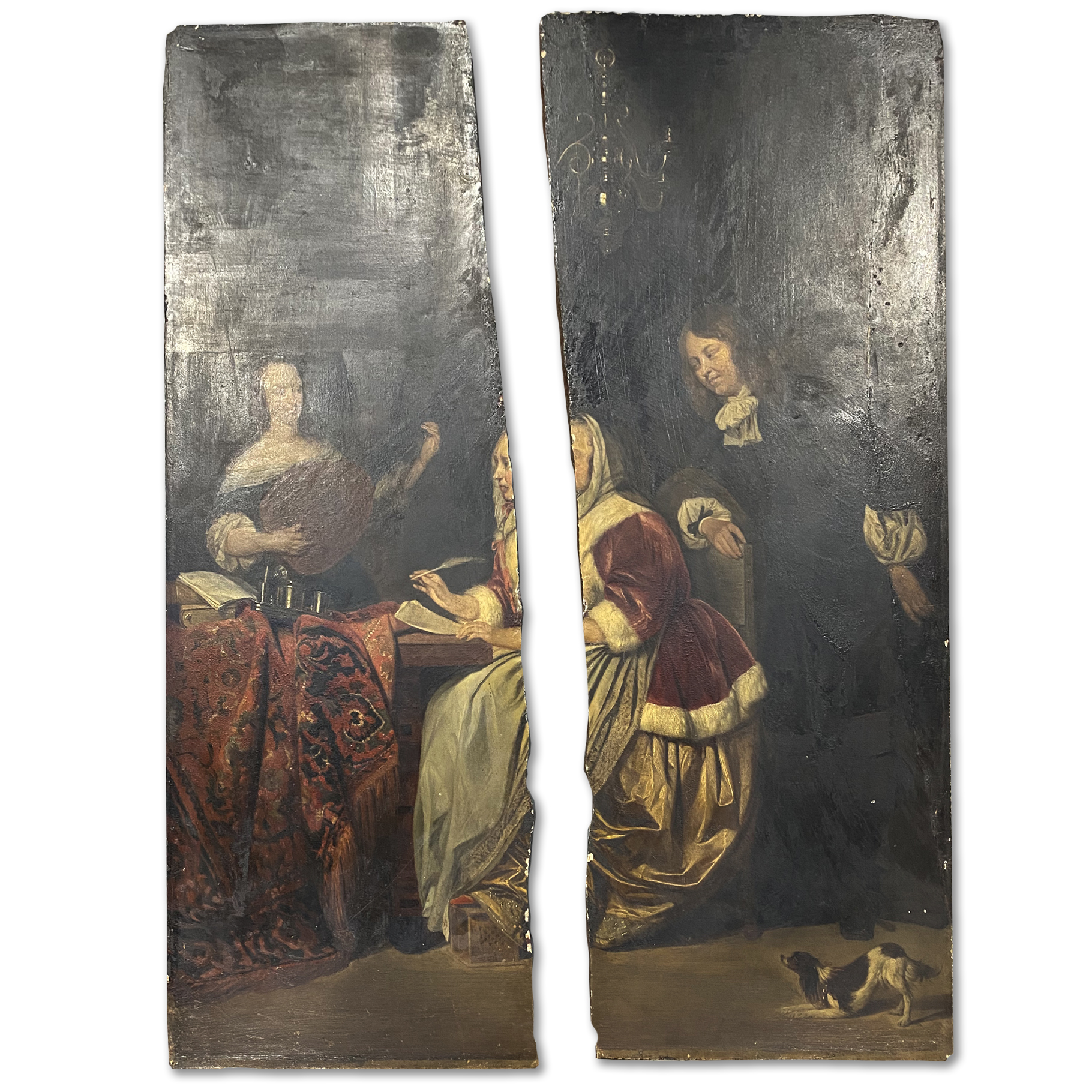
The artwork depicts a beautiful young woman writing a song whilst another plays the lute. A young man stands behind her, is he her lover or husband? One presumed theme of the piece is that it shows a harmonious relationship, the pair working together to compose a good marriage. The small dog at their feet perhaps acting as a sign of loyalty. However, a closer look shows us a stormy sea above the ornate fireplace – could there be trouble ahead? Duets and the composition of music was often depicted as a sign of flirtation in genre paintings of the era. The lady’s foot upon a warming box may be another sign of indulgence. Upon second glance, the dog appears ready to playfully pounce rather than sit loyally at his master’s feet.
The broken panel that our conservators worked on was an excellent copy, capturing the finest elements of the original composition. Unfortunately, it had also become discoloured over time and much of this bright and rich detail had been lost. Before the two broken pieces were re-adhered, the surface was sensitively cleaned and the varnish was removed, allowing the original tones to appear.
A second panel, seen in the video above, had similar levels of discolouration. The scene of a woman plucking a chicken had become yellow due to its original varnish and possibly nicotine, obscuring the bright pigments. Whilst the panel depicts a domestic scene, it also carries a typical lustful undertone through symbolism that is found in many genre paintings.
Our team is often asked to restore both the painting and original frame, this was the case with a Dirck Helmbreker piece. Whilst the painting was conserved and revived, the frame was also cleaned and had new gold leaf applied. To retain the historic appeal, the new gilding was aged down to suit the style of the painting and to meet our client’s preference.

Dirck Helmbreker was a member of the Rome-based Bamboccianti, a group that were known for their small-scale genre scenes. In this painting we see four merry country folk dancing, as two others play music. The movement of the figures may be reflective of the dance of time or simply a moment of carefree rustic life.
Historic alterations
The genre painting below had originally featured a man begging as a central part of the artwork. There were also features such as a bag of money on the ground. These had been covered up in a later era, possibly to make the painting more appealing as decoration for a complacent domestic environment.
 Above: the figure as he was discovered under historic over-paint
Above: the figure as he was discovered under historic over-paint
It is not uncommon for paintings to have been altered in the 19th century, we often see items such as skulls and serpents painted out by religious or superstitious owners, as well as the covering up of nudity. The removal of the beggar from this painting suggests a dislike of socially challenging or politically uncomfortable themes. The original features were returned following the careful removal of over-paint. This not only returned the figure to the scene, but allowed the social context of the artwork to be revived.
 Above: the painting before and after the surface dirt, varnish and over painting were removed
Above: the painting before and after the surface dirt, varnish and over painting were removed
How can we help?
If you have a similar artwork that is in need of care and restoration, speak to a member of our helpful team for advice and an obligation-free quotation.
Please email us today via [email protected] or call 0207 112 7576

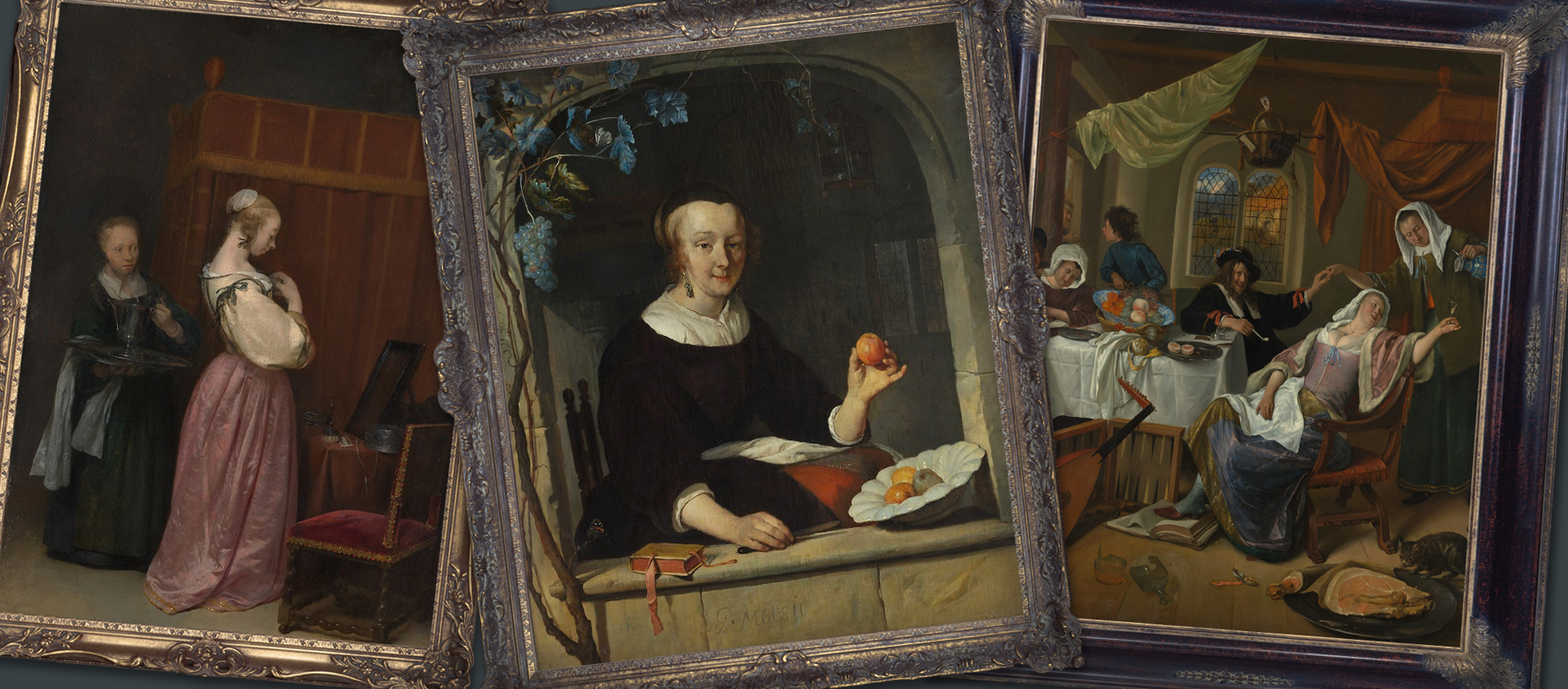 Above: a selection of genre paintings by Gerard ter Borch the Younger (1650), Gabriël Metsu (1660) and Jan Steen (1663)
Above: a selection of genre paintings by Gerard ter Borch the Younger (1650), Gabriël Metsu (1660) and Jan Steen (1663)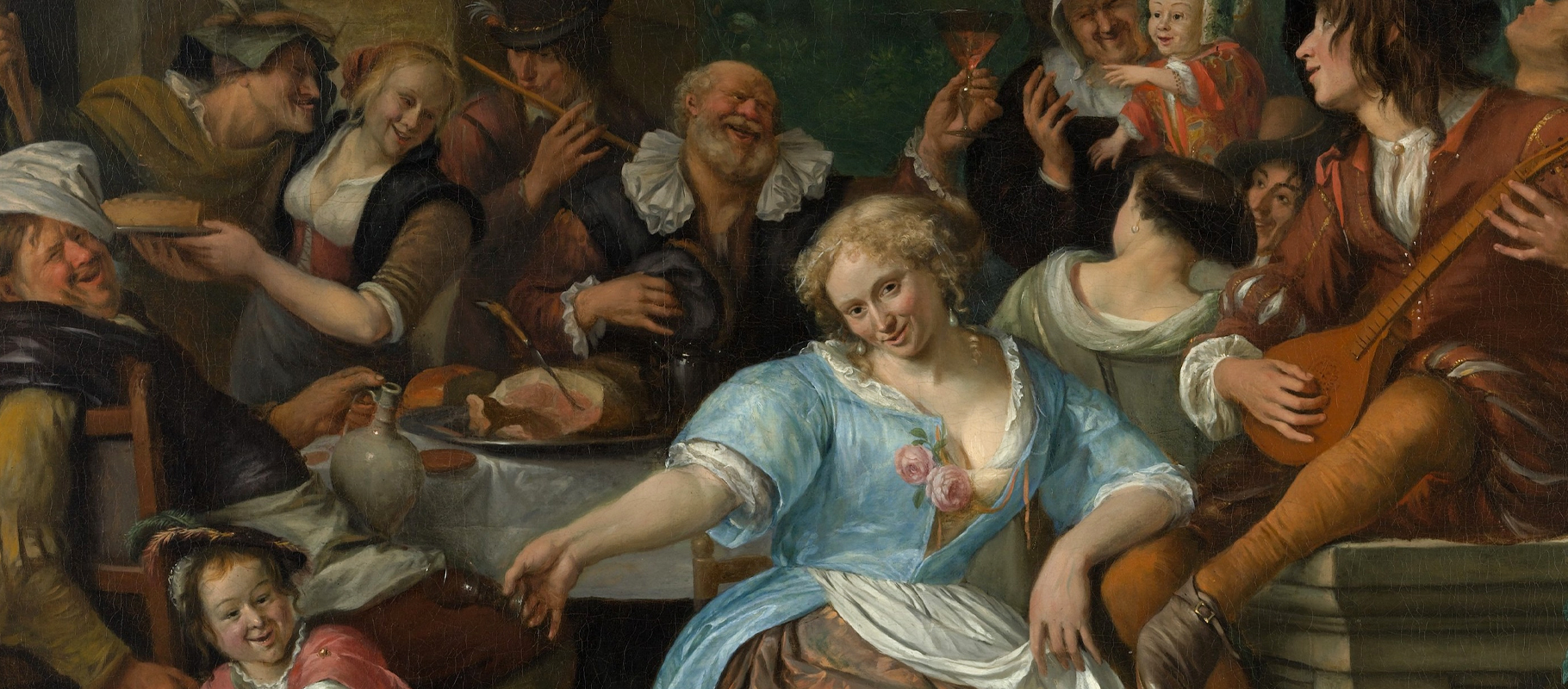 Above: a detail from Merry Company on a Terrace by Jan Steen, 1670
Above: a detail from Merry Company on a Terrace by Jan Steen, 1670 Above: three genre paintings by Vermeer including A Maid Asleep (1656-7), Young Woman with a Water Pitcher (1662) and Young Woman with a Lute (1662-3)
Above: three genre paintings by Vermeer including A Maid Asleep (1656-7), Young Woman with a Water Pitcher (1662) and Young Woman with a Lute (1662-3) Above: a detail from The Feast of St Nicholas by Jan Havicksz Steen, 1665-68
Above: a detail from The Feast of St Nicholas by Jan Havicksz Steen, 1665-68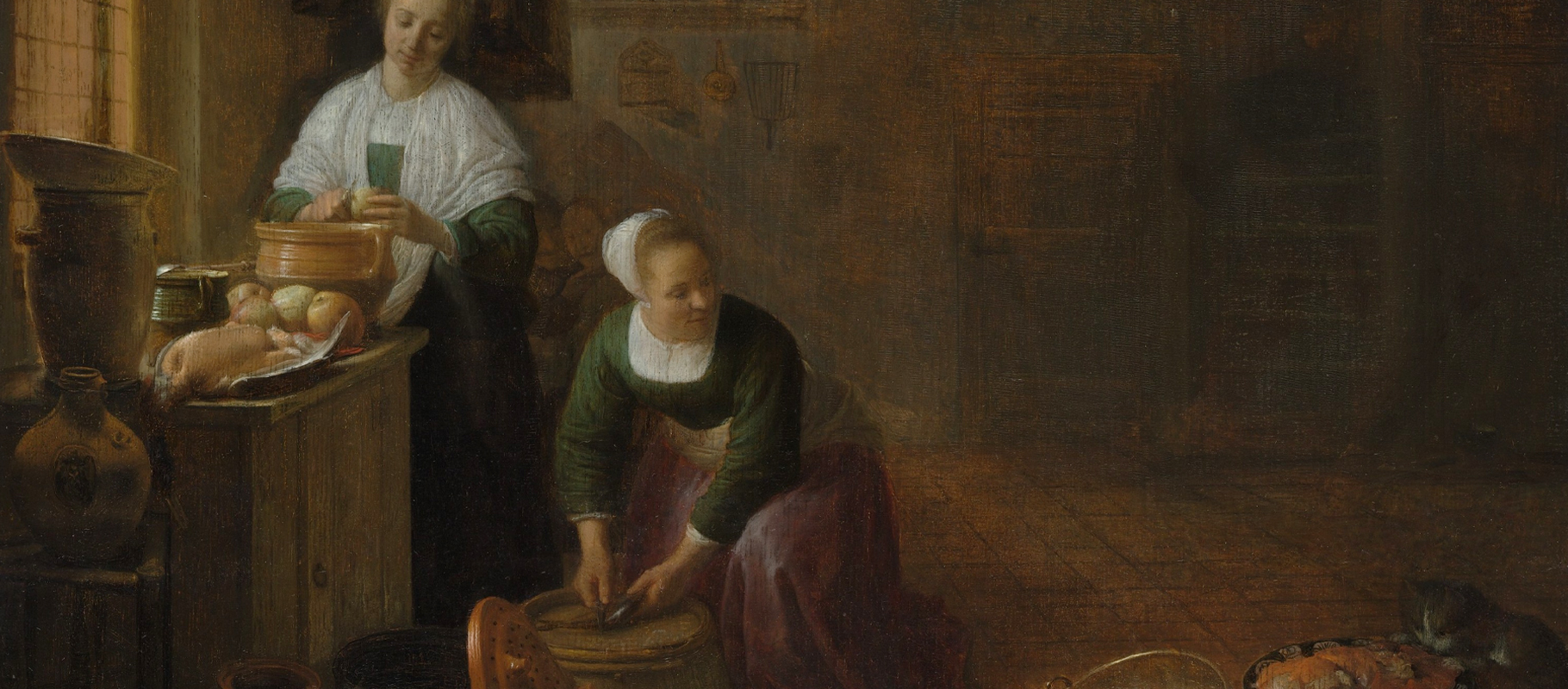 Above: detail from A Kitchen by Hendrick Sorgh, 1643 – this scene has erotic symbolism that would have been obvious to a 17th century viewer
Above: detail from A Kitchen by Hendrick Sorgh, 1643 – this scene has erotic symbolism that would have been obvious to a 17th century viewer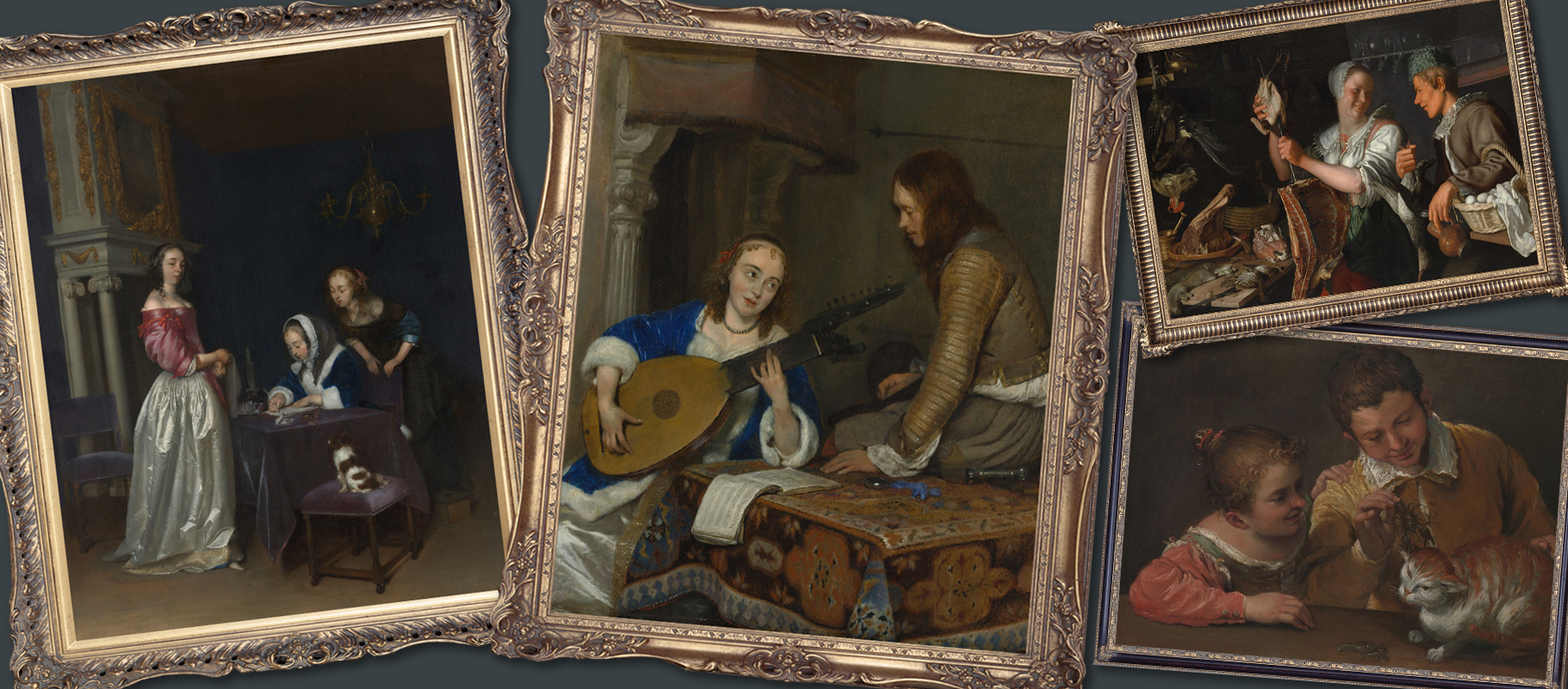 Above: a selection of genre paintings by Gerard ter Borch the Younger, Annibale Carracci and Peter Wtewael
Above: a selection of genre paintings by Gerard ter Borch the Younger, Annibale Carracci and Peter Wtewael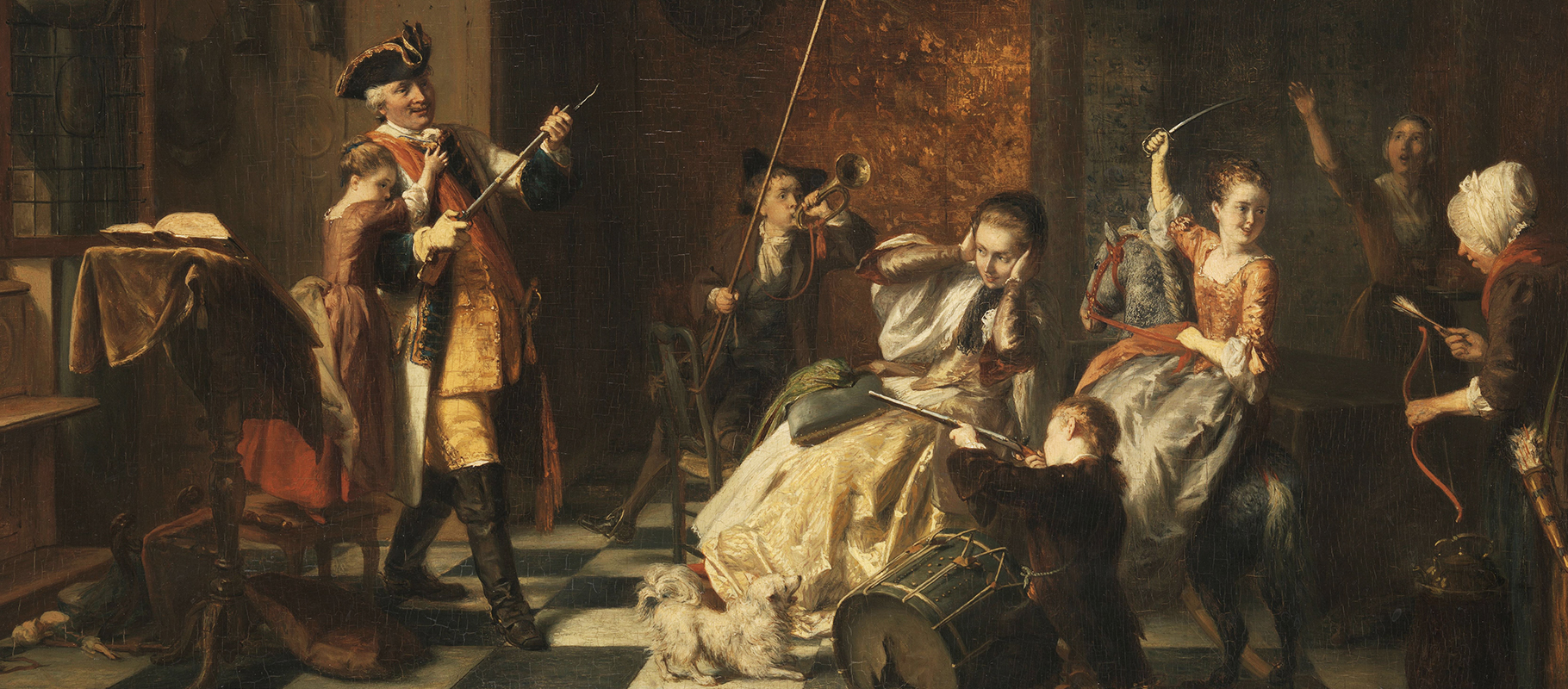 Above: a 19th century genre scene depicting an 18th century family, entitled ‘Each According to Their Own Nature’ by David Bles, 1869
Above: a 19th century genre scene depicting an 18th century family, entitled ‘Each According to Their Own Nature’ by David Bles, 1869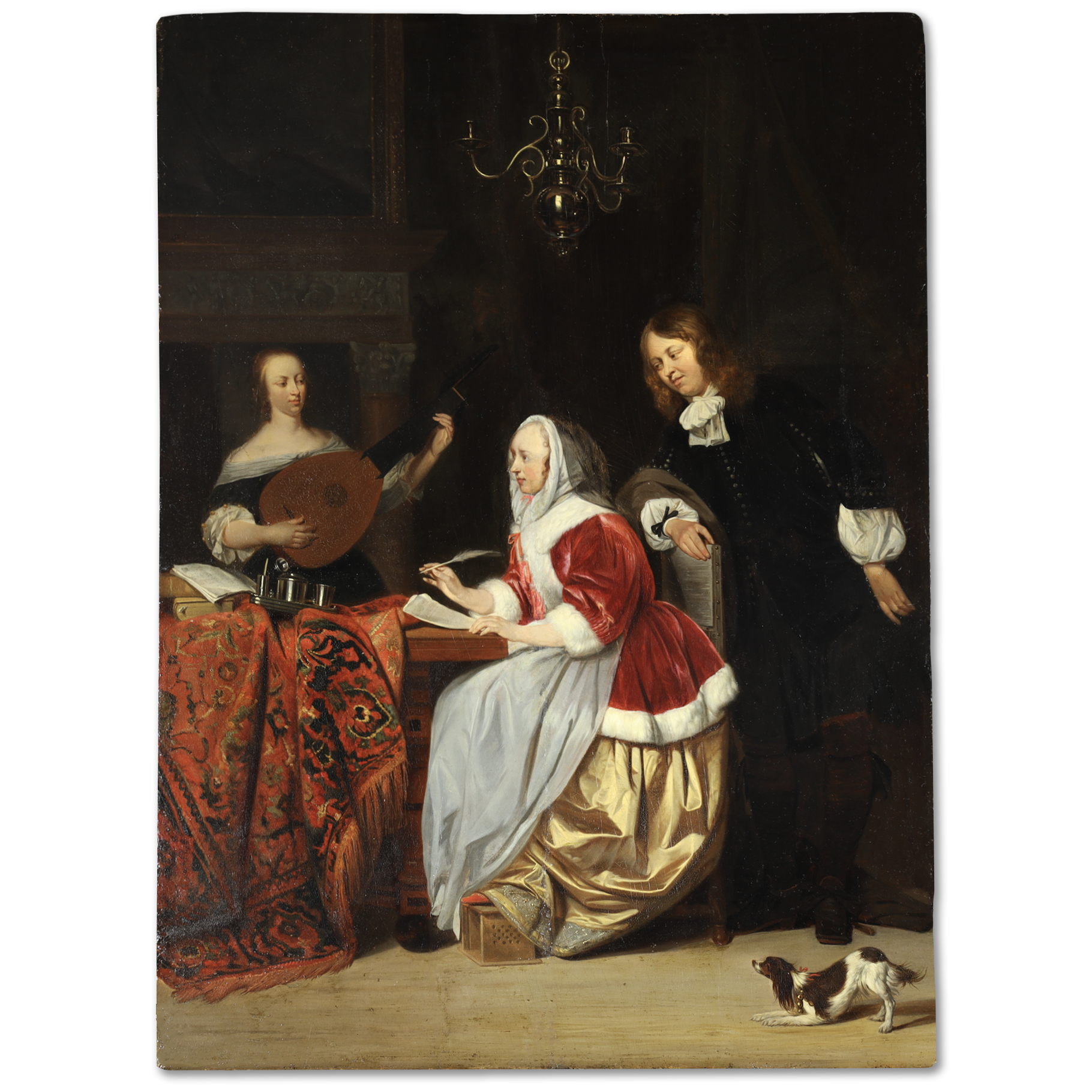
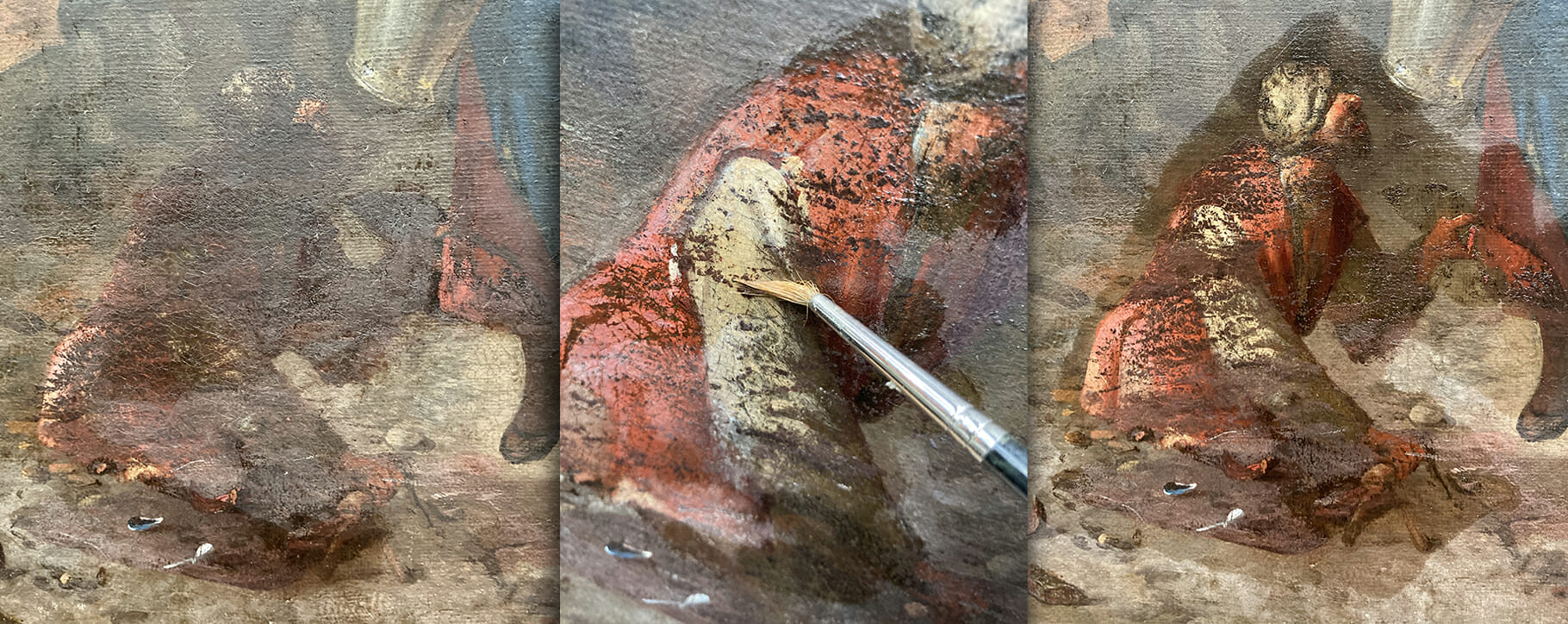 Above: the figure as he was discovered under historic over-paint
Above: the figure as he was discovered under historic over-paint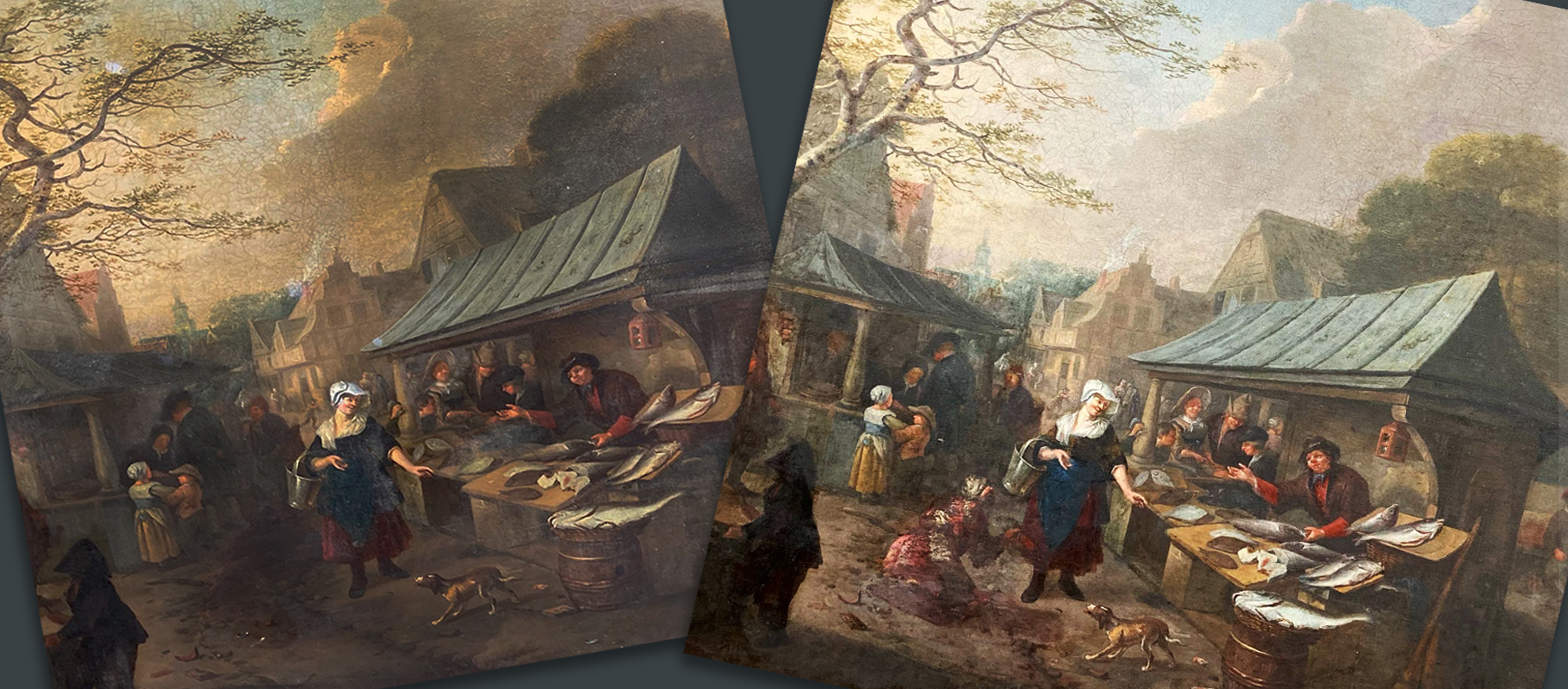 Above: the painting before and after the surface dirt, varnish and over painting were removed
Above: the painting before and after the surface dirt, varnish and over painting were removed




